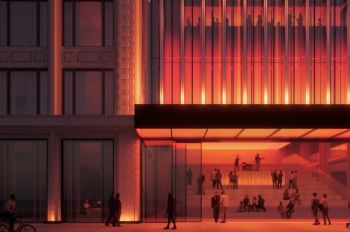Landscapes Are Good for the Environment and the Economy, New Reports Say

How much can a landscape architecture project benefit the neighborhood and environment around it? That’s what College of Architecture Adjunct Professor Sarah Hanson and Matthew Callone (M.L.A.+U 3rd Year) hope to answer in three peer-reviewed research papers published by the Landscape Architecture Foundation.
The papers are a product of Hanson and Callone’s selection to contribute to the foundation’s Landscape Performance Series, which researches the ecological, social, and economical benefits of landscape architecture projects in the United States and abroad. The two looked at three shared landscape spaces in the Chicago area: Argyle Shared Street in the Uptown neighborhood, the Chicago Riverwalk, and the Regenstein Learning Campus at the Chicago Botanic Garden in Glencoe, Illinois.
“The LAF’s goal with this series is to get people—landscape architects, city officials, developers, the general public— to understand the benefits of landscape, green infrastructure, and sustainable features,” says Hanson. “There are alternative methods, there’s using native plants and species, and there’s building a case for not only environmental benefits but economic and social benefits as well.”
These benefits go hand in hand. For instance, Hanson and Callone’s research on Argyle Shared Street shows that the street’s conversion from a standard design to a curb-less design with permeable pavement allows the three-block-long landscape to double its stormwater storage volume, virtually eliminating the need for irrigation of planters, saving as much as 9,300 gallons of water in a month.
Simultaneously, the curb-less design facilitated communal events such as the Argyle Night Market, which saw an approximately 80 percent increase in attendance following the street’s renovation.
“Having that design makes it a more compelling place to do business,” Callone says. “It is definitely a lot livelier. Our social surveys from the night market, for example, showed that a lot of people said they enjoyed coming to this street more after the street’s reconstruction.”
Hanson and Callone identified similar benefits at the Chicago Riverwalk, which, according to a study by University of Michigan, brings in some 780 visitors on a typical summer afternoon, 73 percent of whom were observed engaging in commerce-related activities. The report also says that revenues from Riverwalk concessions designated to pay back the $99 million federal loan used to build the space were an average of 29 percent higher than the city initially projected.
There are tangible environmental benefits, too. The area’s Floristic Quality Index—a measure of plant species within an area—increased from zero to 38.2 following the Riverwalk’s creation. A score of 35 or more on the FQI indicates a space as having a “natural area” quality. Likewise, clever engineering in the form of a cistern water collection system under the Riverwalk’s sloping “theater” steps allows natural water to be used for irrigating, saving water, and introducing floating wetlands that provide a natural habitat for fish, birds, and other wildlife.
Still, while it’s an improvement, Hanson and Callone note that expectations should be somewhat tempered. This is, after all, a downtown area in a large city.
“We didn’t find as many environmental benefits there as we originally suspected,” says Hanson. “I think some of that is due to the popularity of it—there are so many boats on the water now. Some research on the cleanliness of the water suggests it’s improving, but it’s not mind-blowing, at least not yet.”
The most recently published piece from the duo’s research focuses on a six-acre play garden at the Chicago Botanic Garden that uses rolling hills, logs, woodland plants, and water to provide an engaging space for children.
The duo’s research supports the garden’s ambition. Notably, the Chicago Botanic Garden observed 27 percent of children demonstrating use of motor skills, 22 percent using problem-solving skills, and 15 percent displaying empathy. The implementation of native and adaptive species in the space also saved as much as $1,300 in irrigation costs during July 2019; they observed 11 species making use of the new habitats.
Hanson and Callone understand that the scope of their research had limits: not all ecological benefits can be easily quantified and not all of the evidence is new. Still, the incremental benefits of these landscaped areas add up to a larger societal benefit.
“I was interested in doing the work because it strengthens the field. Landscape is everywhere, and it can contribute to the public good,” says Callone. “I think the impact of doing these studies goes beyond the research we’re doing. It’s promoting a landscape ethic.”
Photo: Matthew Callone (M.L.A.+U 3rd Year) [right] is pictured at the Chicago Riverwalk




